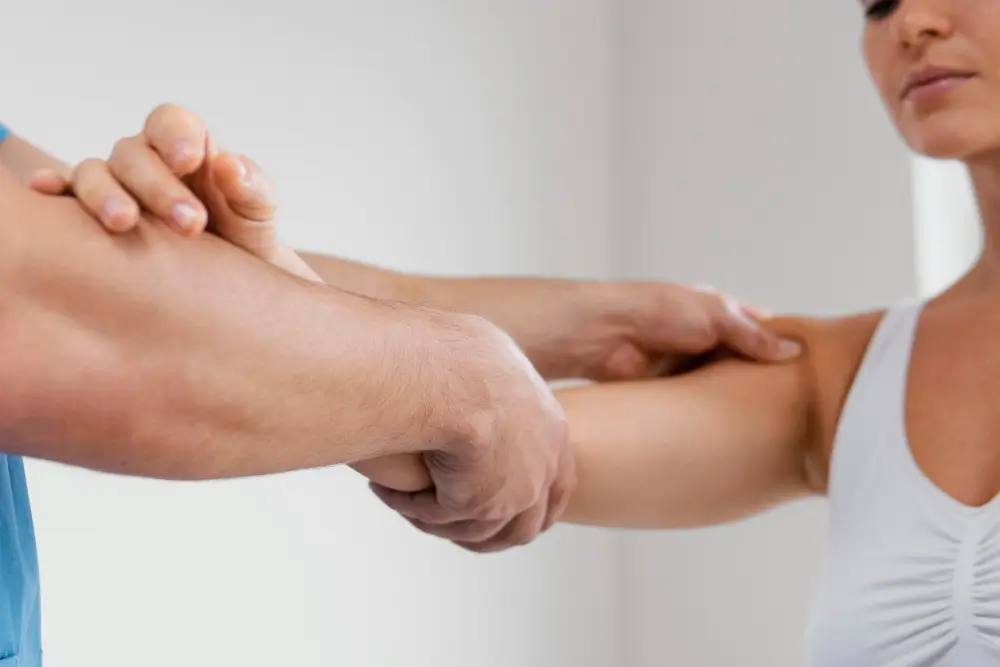What if relieving arthritis pain isn’t in your medicine cabinet, but in how you move? Can physical therapy help with arthritis? As millions look for lasting relief, one question remains: could targeted movement be the game changer? Learn how physical therapy helps arthritis and what to expect.
Move with ease—Start personalized physiotherapy for arthritis pain now!

How Physical Therapy Helps People With Arthritis Feel and Move Better
Physical therapy plays a key role in managing arthritis. It aims to ease symptoms during flare-ups and improve daily life by helping people move better, feel less pain, and avoid long-term complications.
It supports joint mobility through range-of-motion exercises and therapeutic stretching, helping maintain flexibility and reduce the stiffness that often appears in the morning or after being inactive.
Physical therapy also helps reduce joint pain and inflammation, especially during flare-ups. Manual therapy and strengthening exercises offer relief and prepare the body to better handle future episodes with greater resilience and stability.
Stronger muscles ease pressure on the joints, reduce fatigue, and improve balance. Therapy also works to prevent joint deformities in conditions like rheumatoid arthritis through targeted exercises, posture correction, and guidance on safe movement.
The effectiveness of therapy increases when patients stay committed to self-care and attend regular sessions. Seeing a physical therapist before symptoms worsen and maintaining an adapted physical activity routine can make a real difference in arthritis management and overall well-being.
Types of Arthritis That Can Benefit From Physical Therapy
Physical therapy is a key part of managing different forms of arthritis. Using methods like therapeutic exercise, manual techniques, and heat or cold therapy, physical therapists help reduce pain, improve mobility, and promote independence. These are some types of arthritis that benefit the most.
Rheumatoid Arthritis
This chronic autoimmune disease causes ongoing joint inflammation. Physical therapy is helpful during both active and remission phases.
Benefits:
- Pain relief during flare-ups
- Joint deformity prevention
Mobility-preserving exercises - Daily self-care training
Osteoarthritis
This degenerative condition affects joint cartilage over time. While more common in older adults, it can also appear earlier.
Benefits:
- Better joint mobility and reduced mechanical pain
- Muscle strengthening to ease joint load
- Ergonomic guidance and safer movement
Ankylosing Spondylitis
This chronic inflammatory condition mostly affects the spine, causing stiffness and reduced flexibility.
How physical therapy helps:
- Improves posture and prevents deformities
- Increases lung capacity with breathing exercises
- Reduces pain in the lower back and neck
Don’t wait for a flare-up to start therapy. Ongoing treatment helps prepare the body, lower flare-up frequency and intensity, and support a more active life.
These conditions—rheumatoid arthritis, osteoarthritis, and ankylosing spondylitis—benefit greatly from a targeted therapy plan. This approach helps manage physical symptoms and empowers patients with tools and support for daily life.
What to Expect During Arthritis-Focused Physical Therapy
Arthritis-focused physical therapy isn’t one-size-fits-all. It’s a tailored approach built around each person’s specific needs using a mix of movement, treatment, and guidance.
Therapeutic Exercise Programs: A customized exercise plan is a key part of therapy and may include:
- Joint mobility: Gentle exercises to maintain or improve movement range
- Strength training: Focused on areas like the hands, shoulders, or knees to support joints
- Stretching: Helps ease stiffness and preserve flexibility
- Moderate aerobic activity: Walking or biking to improve cardiovascular health with minimal joint stress
Manual Therapy: Physical therapists may use joint mobilization techniques to boost range of motion and relieve tension. This is especially helpful for joint stiffness or restricted movement and complements the patient’s active efforts.
Assistive Devices: For people struggling with walking or daily tasks, physical therapists may recommend:
- Crutches or canes: To reduce pressure on joints like the knees
- Adaptive tools: Ergonomic items that help with everyday activities, especially if hand movement is limited
Using these tools properly can improve safety and independence.
Patient Education and Daily Strategies: Therapy includes teaching patients how to manage their condition day by day. This can involve:
- Keeping proper posture
- Avoiding painful or risky movements
- Using heat or cold safely
- Spotting early signs of flare-ups
These strategies help patients manage their condition more effectively.
A Personalized and Comprehensive Approach: Each arthritis case is different, so therapy must be adjusted to the person’s mobility level, pain, and personal goals. A complete plan addresses both symptoms and the root causes, like inflammation and joint deterioration.
During therapy, patients can expect a well-rounded program that supports them in living more actively and confidently. Progress depends on consistency, customization, and professional support.
How to Get Started and Whether You Need a Referral
The best way to begin is by speaking with your general doctor or rheumatologist. They can give a personalized recommendation based on your diagnosis. In many health systems, especially public ones or those with insurance coverage, a formal referral may be needed to access specialized physical therapy services.
You can also look into arthritis-specific programs at hospitals, rehab clinics, or local fitness centers. These programs often include exercise routines designed and supervised by professionals, making it easier and safer to get started.
There’s no cure for arthritis, but physical therapy can make a real difference in managing symptoms. With a care plan tailored to your condition, you can work on restoring movement, strengthening affected areas, and regaining lost function.
Sources:
- Reese, E. P. (1958). ARTHRITIS—The Use of Physical Therapy as an Aspect of Management. California Medicine, 89(3), 204.
- Minor, M. A., & Sanford, M. K. (1999). The role of physical therapy and physical modalities in pain management. Rheumatic Disease Clinics of North America, 25(1), 233-248.
